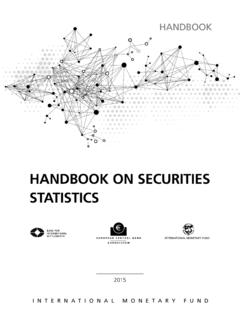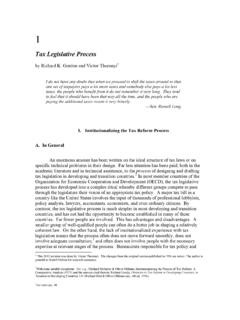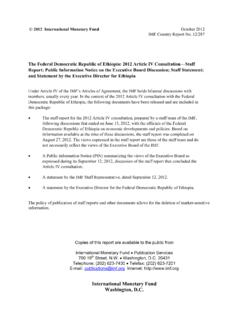Transcription of Tackling Small and Medium Sized Enterprise Problem Loans ...
1 March 2015 SDN/15/04 I M F S T A F F D I S C U S S I O N N O T E Tackling Small and Medium Sized Enterprise Problem Loans in Europe Wolfgang Bergthaler, Kenneth Kang, Yan Liu, and Dermot Monaghan I N T E R N A T I O N A L M O N E T A R Y F U N D Tackling Small AND Medium Sized Enterprise Problem Loans IN EUROPE 2 international monetary fund international monetary fund European Department, Legal Department, and monetary and Capital Markets Department Tackling Small and Medium Sized Enterprise Problem Loans in Europe Prepared by Wolfgang Bergthaler, Kenneth Kang, Yan Liu, and Dermot Monaghan1 Authorized for distribution by Sean Hagan, Poul M. Thomsen, and Jos Vi als March 2015 DISCLAIMER: This Staff Discussion Note represents the views of the authors and does not necessarily represent IMF views or IMF policy.
2 The views expressed herein should be attributed to the authors and not to the IMF, its Executive Board, or its management. Staff Discussion Notes are published to elicit comments and to further debate. JEL Classification Numbers: K22, G33, G38, E440 Keywords: SME; debt restructuring; Europe; insolvency; economic recovery; debt distress Authors E-mail Addresses: 1 The authors would like to thank Manfred Balz, Leif Clark, Jorg Decressin, Jose M. Garrido, Sean Hagan, Bruce Markell, Marina Moretti, Ceyla Pazarbasioglu, Mahmood Pradhan, Nadia Rendak, and Ignacio Tirado for their comments and Lorenzo Arditi, Katie Cincotta, Gisele Fanali, Sebastiaan Pompe, Anjum Rosha, Sergejs Saksonovs, Jesse Siminitz, and David Velazquez-Romero for their contributions to the note.
3 Tackling Small AND Medium Sized Enterprise Problem Loans IN EUROPE international monetary fund 3 CONTENTS EXECUTIVE SUMMARY _____ 5 INTRODUCTION _____ 6 CHALLENGES IN RESOLVING SME Problem Loans _____ 8 RECENT POLICY SUPPORT FOR SMES _____ 11 LESSONS FROM international EXPERIENCES _____ 16 POLICY RECOMMENDATIONS FOR Tackling SME Problem Loans IN EUROPE _____ 20 CONCLUSION _____ 26 BOXES 1. Definition of SMEs _____ 6 2. EC Recommendation for a New Approach to Business Failure and Insolvency _____ 14 3. Main Features of Bankruptcy's Chapters for Small and Medium Sized Enterprises _____ 17 4. Priority and Protection of Provision of Fresh Money to Distressed Small and Medium Sized Enterprises _____ 22 5. A Standardized Approach to SME Debt Restructuring in Systemic Crisis _____ 26 ANNEX international Experience with SME Debt Restructring _____ 28 REFERENCES _____ 31 FIGURES 1.
4 Nonfinancial Corporate Debt _____ 7 2. Post-Asset Quality Review Nonperforming Exposures _____ 7 3. Share of SME Loans in Stocks, 2012 _____ 7 4. Nonperforming Exposure _____ 7 5. SME and Large Firm Borrowing Rates _____ 7 6. Strength of Insolvency and Legal Procedures and Nonperforming Loans in Advanced Economies, 2013 _____ 7 7. SME Share in Employment and Cumulative Output Growth in the EU _____ 8 Tackling Small AND Medium Sized Enterprise Problem Loans IN EUROPE 4 international monetary fund Glossary AQR Asset Quality Review EC European Commission ECB European Central Bank EU European Union GDP Gross Domestic Product IMF international monetary fund INSOL international Association of Restructuring, Insolvency & Bankruptcy Professionals NPL Nonperforming Loans SAAR Seasonally Adjusted Annual Rate SME Small and Medium Sized Enterprise OECD Organization for Economic Co-operation and Development UNCITRAL United Nations Commission on international Trade Law Tackling Small AND Medium Sized Enterprise Problem Loans IN EUROPE international monetary fund 5 EXECUTIVE SUMMARY The global financial crisis has left a large private sector debt overhang and high levels of nonperforming Loans (NPLs) in several European countries.
5 Small and Medium - Sized enterprises (SMEs) represent a significant and weak segment of the nonfinancial corporate sector. SMEs face a number of legal, financial, and regulatory challenges to restructuring that differ from those of larger corporates, such as a rigid and costly insolvency regime, a higher fixed cost to loan restructuring, and the lack of alternative sources of financing. Given SMEs large presence and close links to the banking system, addressing the SME loan Problem in Europe will be critical for strengthening bank and corporate balance sheets and supporting a more robust and sustained recovery. The European Union and its member states have taken a number of steps to support distressed SMEs, from insolvency reforms and strengthened banking supervision, to financial support, but given the high debt overhang and NPL levels, more is needed to accelerate the resolution of Problem Loans and assist viable but distressed SMEs.
6 Based on cross-country experience with distressed SMEs, a comprehensive strategy can help promote NPL resolution and restructuring in Europe. Such a strategy should include tighter regulation and supervision of banks NPL management, insolvency reform targeted at SMEs, a greater push for out-of-court workouts, and supportive macro policies. The aim should be to provide more cost-effective, efficient tools and to strengthen the incentives for restructuring and resolution. Moral hazard risks should be addressed by ensuring the speedy exit of nonviable SMEs: Building on recent insolvency reforms in many European countries, establishing simplified procedures for SMEs would reduce the cost and inefficiencies of SME restructuring. Insolvency regimes should close the gap with international best practices for rapid pre-pack approvals, fresh start /debt discharge, and debtor-in-possession financing.
7 Active involvement of public creditors would support the restructuring of viable SMEs. Enforcement and foreclosure systems should be enhanced and made effective. Against the backdrop of a sound insolvency system, guidelines on loan workouts and the increased use of mediation would support more out-of-court debt restructuring. Following the completion of the European Central Bank s comprehensive assessment, supervisors should ensure that banks are adequately capitalized and provisioned in a forward-looking manner to provide sufficient resources for case-specific resolution or restructuring. For SMEs in particular, proper collateral valuation is critical. For systemic cases where assessing SME viability is challenging, regulators may need to undertake a triage approach to separate nonviable SMEs for speedy liquidation from viable but distressed ones for more standardized loan restructuring and to force loss recognition through time-bound write-offs.
8 Other supportive policies include removing tax and regulatory impediments to NPL resolution, improving SME financial reporting and disclosure, and expanding SMEs access to financing, such as through securitization and active use of government support Small AND Medium Sized Enterprise Problem Loans IN EUROPE 6 international monetary fund INTRODUCTION 1. Six years since the global financial crisis, the problems of high levels of corporate debt and nonperforming Loans (NPLs) still persist in several European countries. Nonfinancial corporate debt as a share of GDP rose sharply before the crisis and has come down only slightly from its peak (Figure 1). In many countries, the pressure on corporates to deleverage has held back investment, which remains well below precrisis levels (Barkbu 2015).
9 Reflecting the weak recovery, NPLs in the corporate sector have also risen sharply and, as highlighted in the European comprehensive assessment, have reached systemic levels in some distressed countries (Figure 2). 2. Small and Medium - Sized enterprises (SMEs) represent a particularly significant and weak segment of the corporate sector. SMEs in the European Union (EU) account for percent of the million nonfinancial enterprises, about 58 percent of value added, and nearly two-thirds of employment (Box 1; EC 2013b). Their share in total business Loans range from 20 percent to as high as 75 percent in some countries (Figure 3). Compared with large firms, SMEs in general are more leveraged and reliant on bank financing and have significantly higher NPL ratios (Figure 4).
10 2 High SME NPLs reflect in part the deep and prolonged recession that hit SMEs hard, both through the collapse in domestic demand and the tightening of credit conditions (Iyer and others 2014; Presbitero and others 2014). Despite the declines in sovereign yields, SME borrowing rates have declined by much less and remain high compared with those for large firms (Figure 5). 3. SMEs present a particular set of challenges for NPL restructuring and resolution. Given the large number of SMEs and their Small sizes, lower reporting requirements, and heavy reliance on collateral, SME loan restructuring is more costly and riskier for banks than for large firms. In many cases, insolvency and out-of-court workout frameworks are ill-suited for SMEs, limiting the restructuring options, while difficulties in foreclosing on collateral also prevent speedy liquidation and exit.



















